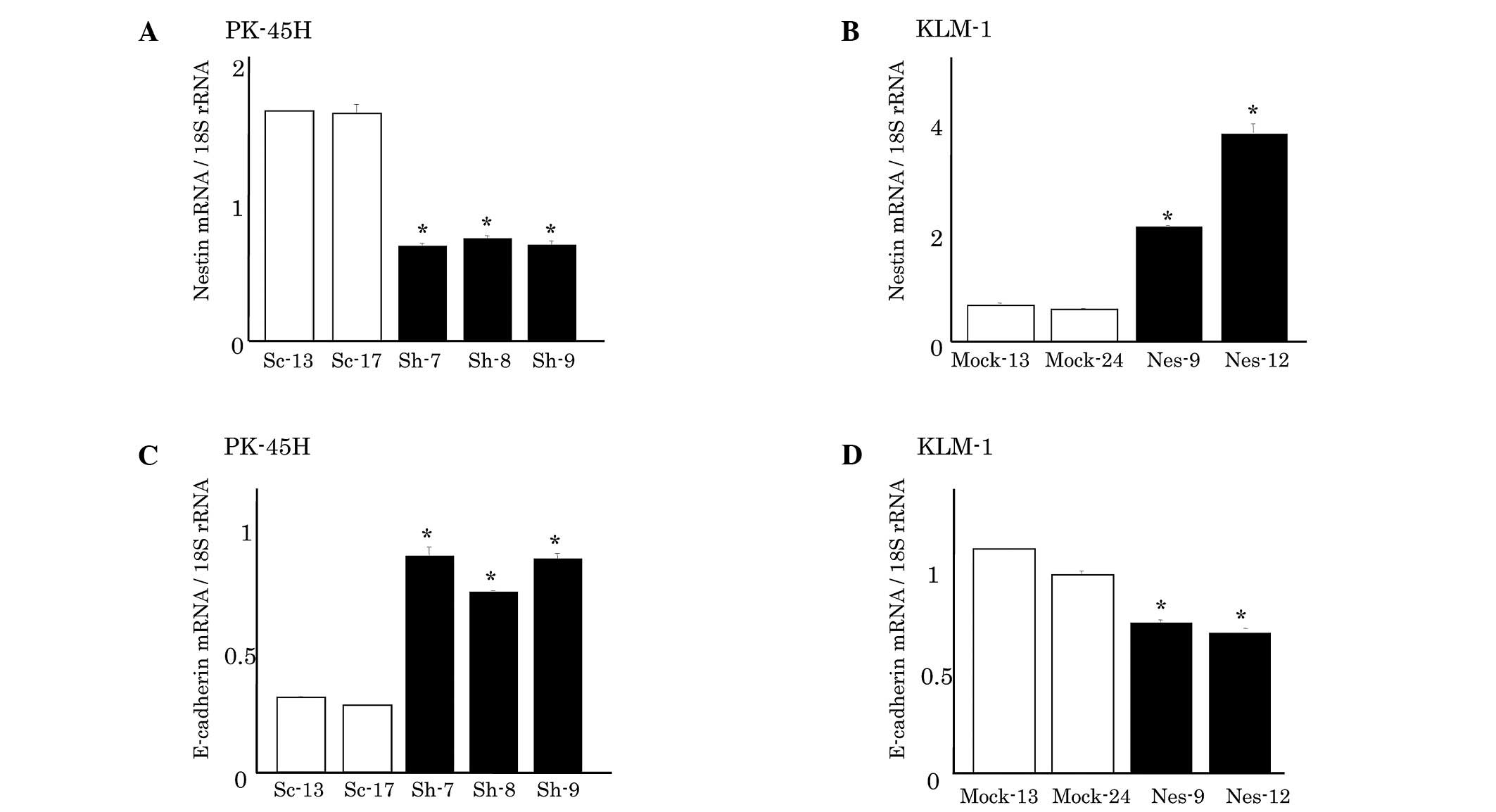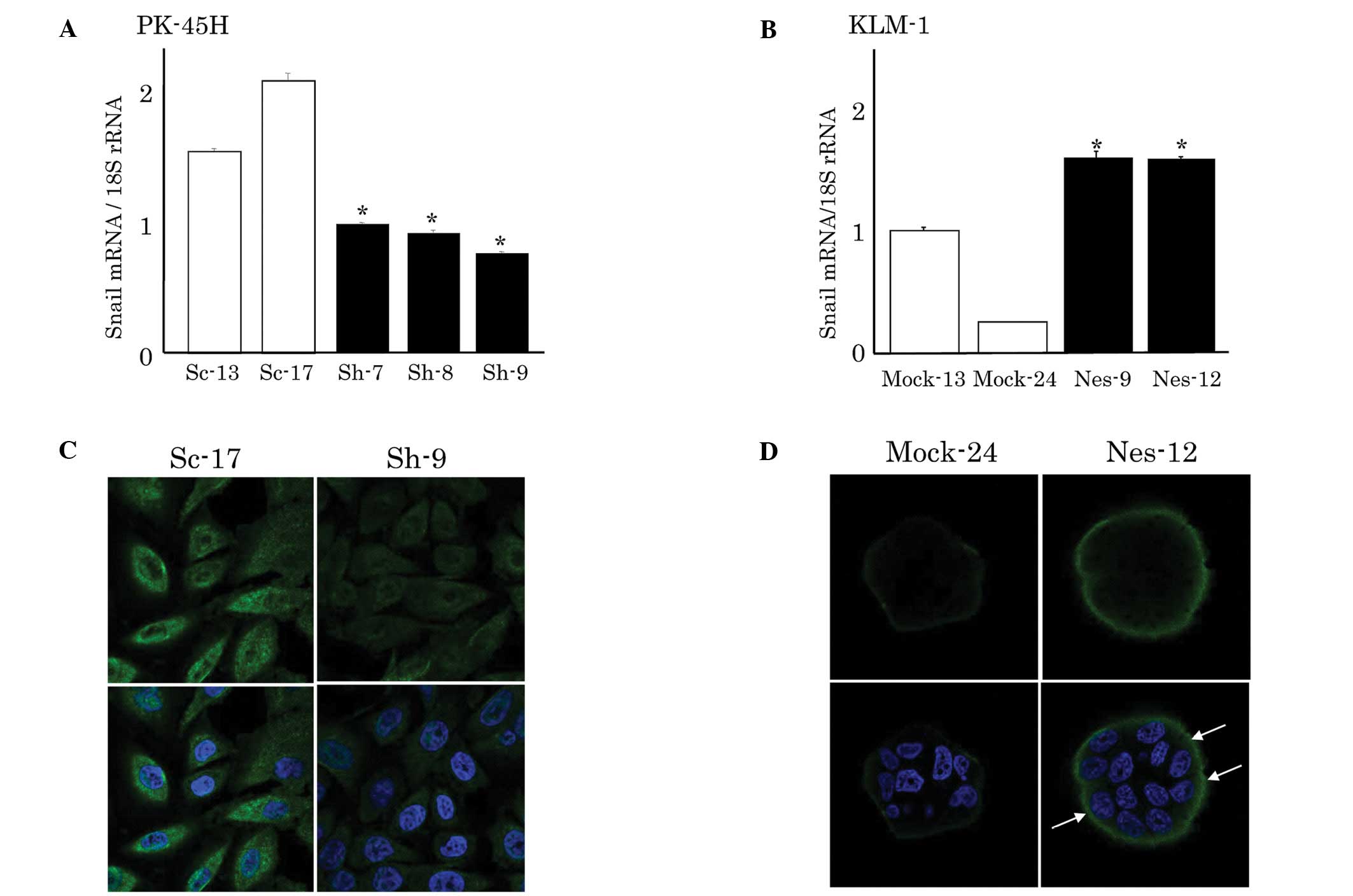Nestin regulates epithelial-mesenchymal transition marker expression in pancreatic ductal adenocarcinoma cell lines
- Authors:
- Published online on: June 8, 2012 https://doi.org/10.3892/mco.2012.1
- Pages: 83-87
Abstract
Introduction
Pancreatic ductal adenocarcinoma (PDAC) is associated with extremely high mortality rates due to rapid progression and high incidences of metastases, peritoneal dissemination and recurrence (1). Therefore, there is an urgent need for new therapeutic strategies that are focused on preventing the invasion and metastasis of pancreatic cancer cells.
Nestin, a class VI intermediate filament, was first described as a neuronal stem/progenitor cell marker that is expressed in progenitor cells of various tissues, including pancreas (2). Lineage-tracing experiments have shown that exocrine cells in the pancreas are derived from nestin-expressing progenitor cells (3–5). An increased nestin expression has been reported in various tumors, including pancreatic cancer (6). Nestin immunoreactivity was found to be present in the cancer cells in approximately 30% of PDAC cases. Moreover, nestin expression in pancreatic cancer cells was found to correlate with nerve invasion and the presence of cancer cells at the tumor resection margins (7). Suppression of the nestin expression was found to inhibit the invasion and migration of PDAC cells in vitro, and inhibit liver metastasis in a xenograft mouse model (8). These findings suggest that nestin is important in the aggressiveness of pancreatic cancer cells.
The epithelial-mesenchymal transition (EMT), in which cells undergo a morphological switch from the epithelial polarized phenotype to the mesenchymal fibroblastoid phenotype, is considered to occur during cancer invasion and metastasis (9). Several distinct traits are conveyed by EMT, including cell motility and invasiveness (10). As a result of EMT, epithelial cells lose their defined cell-cell/cell-substratum contacts and their structural/functional polarity, and become spindle-shaped and morphologically similar to activated fibroblasts (11). At the molecular level, EMT is defined by the loss of cell-cell adhesion molecules (e.g., E-cadherin and ZO-1), downregulation of epithelial differentiation markers (e.g., cytokeratins and E-cadherin), transcriptional induction of mesenchymal markers (e.g., vimentin, fibronectin, and N-cadherin) and the nuclear localization of β-catenin (12). E-cadherin plays a major role in EMT, and the Snail, Twist, and SIP-1/ZEB-2 proteins are all repressors of the gene CDH1 that codes for E-cadherin.
We hypothesized that nestin regulates the migration and invasion of PDAC cells via interactions with EMT factors. In the present study, we modulated the nestin expression in PDAC cells and investigated the corresponding changes in the mRNA and protein levels of major EMT factors.
Materials and methods
Reagents and chemicals
The following reagents and chemicals were purchased: FuGene HD transfection reagent from Roche Diagnostics (Mannheim, Germany); geneticin from Gibco-BRL (Grand Island, NY, USA); pBAsi-hU6 Neo DNA vector and FastPure RNA kit from Takara Bio, Inc. (Tokyo, Japan); pAcGFP1-N1 vector from Clontech Laboratories (Mountain View, CA, USA) and the High Capacity cDNA Reverse Transcription kit. TaqMan Fast Universal PCR Master Mix, and TaqMan Gene Expression Assays for nestin (Hs00707120_s1), E-cadherin (Hs01013953_m1), Snail (Hs00195591_m1), Slug (Hs00950344_m1), Twist (Hs00361186_m1), and 18S rRNA (Hs99999901_s1) were obtained from Applied Biosystems, Inc. (Foster City, CA, USA). Rabbit polyclonal anti-Snail antibody was purchased from Abcam (Cambridge, UK); Alexa 488-labeled goat anti-rabbit IgG antibody was purchased from Invitrogen Life Technologies (Carlsbad, CA, USA); and Vectashield H-1200 containing 4′,6-diamidino-2-phenylindole-2HCl (DAPI) was obtained from Vector Laboratories (Burlingame, CA, USA). All other chemicals and reagents were purchased from Sigma-Aldrich (St. Louis, MO, USA).
Pancreatic cancer cell lines
PK-45H and KLM-1 human pancreatic cancer cells were obtained from the Cell Resource Center for Biomedical Research, Institute of Development, Aging, and Cancer, Tohoku University, Japan. Cells were grown in RPMI-1640 medium containing 10% fetal bovine serum (FBS) at 37°C under a humidified 5% CO2 atmosphere.
Establishment of nestin short hairpin RNA-transfected PK-45H cells
Human nestin short hairpin (sh) RNA was prepared as previously reported (8). PK-45H cells (1×105 cells/well) were plated in 6-well plates and grown in 2 ml RPMI-1640 medium with 10% FBS. Transfections of the nestin shRNA expression and sham vectors were performed using FuGENE HD transfection reagent, according to the manufacturer’s instructions. Independent colonies were isolated by ring cloning, and expanded in 300 μg/ml geneticin. Cell lysates were collected, and nestin mRNA was measured by quantitative RT-PCR (qRT-PCR).
Establishment of nestin-expressed vector-transfected KLM-1 cells
The full-length nestin cDNA fragment was ligated into the pAcGFP1-N1 eukaryotic expression vector as reported in a previous study (8). Transfections with the nestin expression vector (Nes) and the empty vector (Mock) were performed using FuGENE HD transfection reagent. The cells were passaged and cultured with 600 μg/ml geneticin. Independent colonies were isolated by ring cloning and expanded in 300 μg/ml geneticin.
qRT-PCR
Total RNA was extracted from cells and purified with the FastPure RNA kit. One microgram of the total RNA sample was used for reverse transcription (RT) with the High Capacity cDNA Reverse Transcription kit following the manufacturer’s protocol. qRT-PCR for nestin, E-cadherin, Snail, Slug, Twist and 18S rRNA was performed with the StepOnePlus Real-Time PCR System (Applied Biosystems, Inc.) using specific primers and a TaqMan probe. Cycling conditions were as follows: denaturation for 20 sec at 95°C, followed by annealing for 40 cycles of 1 sec at 95°C and a final extension for 20 sec at 60°C. qRT-PCR results were expressed as the ratio of the target to 18S rRNA, the latter serving as an internal standard. Gene expression levels were measured in triplicate.
Immunocytochemistry
Cells were plated in 35-mm glass-bottomed dishes (2×105 cells/dish) and incubated for 72 h at 37°C in a humidified 5% CO2 atmosphere. The cells were fixed in 4% paraformaldehyde solution for 15 min at room temperature, and incubated overnight at 4°C with polyclonal rabbit anti-Snail antibody. Cells were then incubated with Alexa 488-labeled anti-rabbit IgG antibody (1:1000 dilution), and mounted in Vectashield H-1200. Snail protein was visualized using a Digital Eclipse C1 TE2000-E microscope (Nikon Instech Co., Ltd., Tokyo, Japan). Fluorescent images were analyzed using control software EZ-C1 (Nikon). Confocal settings, including the laser power and detector sensitivity, were unchanged during the acquisition of all images.
Statistical analysis
Quantitative data were shown as the mean ± SEM. One-way ANOVA was used to compare data for each shRNA clone separately for the corresponding values for each of two sham clones. P<0.05 was considered to indicate a statistically significant difference with respect to each of the two sham clones. Data for transiently nestin gene-transfected cells and corresponding Mock-transfected cells were assessed by the Student’s t-test. Computations were performed using the Stat View J version 5.0 software package (SAS Institute, Inc., Cary, NC, USA).
Results
Increase and decrease in expression levels of nestin and E-cadherin in PK-45H and KLM-1 cells
Nestin mRNA expression levels in PK-45H and KLM-1 cells were analyzed using qRT-PCR (Fig. 1). In PK-45H cells, nestin shRNA-transfected clones (Sh-7, −8, and −9) exhibited a markedly decreased nestin expression compared with the sham vector-transfected cells (Sc-13 and −17) (Fig. 1A). Sh-7 cells showed the lowest nestin expression, approximately 40% lower than that of Sc-13 cells. By contrast, KLM-1 cells originally expressed low levels of nestin, and nestin-expressed vector-transfected KLM-1 cells (Nes-9 and −12) expressed higher nestin levels than the empty vector-transfected clones (Mock-13 and −24) (Fig. 1B). Nes-12 cells showed the highest nestin expression level, which was approximately eight times the level of Mock-24 cells.
Furthermore, we examined the expression of EMT markers, including E-cadherin, a major marker for epithelial cells (Fig. 1). The nestin-suppressed PK-45H clones exhibited a markedly increased E-cadherin expression (Fig. 1C). By contrast, the nestin-overexpressed KLM-1 clones showed significantly decreased E-cadherin mRNA levels (Fig. 1D).
mRNA expression and immunostaining of Snail in PK-45H and KLM-1 cells
To investigate whether altered nestin expression levels affected E-cadherin expression through transcriptional factors, we analyzed the expression of Snail, Slug and Twist. However, Twist expression was not high enough to detect, which is consistent with previous findings (13). Suppression of nestin expression significantly decreased the Snail mRNA expression in PK-45H cells compared with that in sham-transfected Sc clones (Fig. 2A). In addition, the Snail protein expression was apparently decreased in the cytoplasm and nucleus of Sh-9 cells (Fig. 2C). By contrast, Snail mRNA expression was significantly higher in the nestin-expressed vector-transfected KLM-1 cells compared to the Mock-transfected cells (Fig. 2B). Similarly, an increased Snail protein expression was detected in these cells (Nes-9 and −12) (Fig. 2D).
mRNA expression of Slug in PK-45H and KLM-1 cells
Slug expression was not significantly different between the Sc and nestin-suppressed Sh PK-45H clones (Fig. 3A). However, the nestin-overexpressed KLM-1 cells showed a significantly decreased Slug mRNA expression (Fig. 3B).
Discussion
The correlation between the cytoskeletal proteins nestin and E-cadherin in cancer cells remains to be elucidated. Thyroid carcinomas exhibit a high nestin expression, while E-cadherin expression is not detected in anaplastic (undifferentiated) carcinoma. By contrast, E-cadherin, but not nestin, is expressed in papillary and follicular carcinomas (14). The association between these proteins in pancreatic cancer has yet to be adequately clarified. Results of our previous study have shown an increased E-cadherin expression in nestin-suppressed PDAC cells (8). Findings of the present study have shown that nestin overexpression induced the E-cadherin expression, strengthening the association between nestin and E-cadherin.
EMT occurs during various developmental processes, such as gastrulation, neural crest migration and heart formation (15–18). EMT is also involved in pathological processes, such as fibrosis and metastasis (19). The molecular mechanisms controlling EMT have only recently begun to emerge, and key roles have been identified for the zinc finger transcription factors Snail (Snail1) and Slug (Snail2) (20,21). In the present study, E-cadherin was negatively correlated with Snail expression, which is consistent with previous reports that indicate Snail is a repressor of E-cadherin and directly regulates E-cadherin expression via the integrin-linked kinase (ILK) pathway (22). We observed that the Snail expression responded to the increase and decrease of nestin, indicating that nestin is closely correlated with EMT and may thus modulate EMT.
Slug was found to behave differently to Snail. In chicks, Slug has been identified in two developmental processes involving EMT, as a key regulator of mesoderm formation and neural crest migration (23). Another study reported differential effects of Snail and Slug in pancreatic cancer, relating to the interplay between Rho signaling and β1-integrin, and leading to differences in cell migration and scattering (24). Our findings suggest that Slug expression is less involved in EMT via the nestin-induced change of E-cadherin. Twist was not detected in this study; however, it may be involved. Twist reportedly may act through a different mechanism compared to Snail and Zeb proteins (25), and immunohistochemical analysis has detected a decreased expression of nuclear Twist in malignant pancreatic epithelium (26).
In conclusion, the results of this study suggest that nestin may modulate the expression of E-cadherin and Snail, thereby affecting the migration and metastasis of pancreatic cancer.
Acknowledgements
The authors thank Dr Z. Naito for his helpful discussion and Ms. K. Kawahara, Mr. Y. Yanagisawa and Ms. Y. Kawamoto (Department of Pathology, Integrative Oncological Pathology) for their excellent technical assistance. This study was supported by a Grant-in-Aid for Young Scientists (A, no. 22689038 to Y. Matsuda and B, no. 24791451 to M. Hagio), a Grant-in-Aid for Challenging Exploratory Research (no. 23650604 to Y. Matsuda) and a Grant-in-Aid for Scientific Research (C, no. 22591531 to T. Ishiwata) from the Japan Society for the Promotion of Sciences. This study was also supported by a grant from the Pancreas Research Foundation of Japan to M. Hagio.












